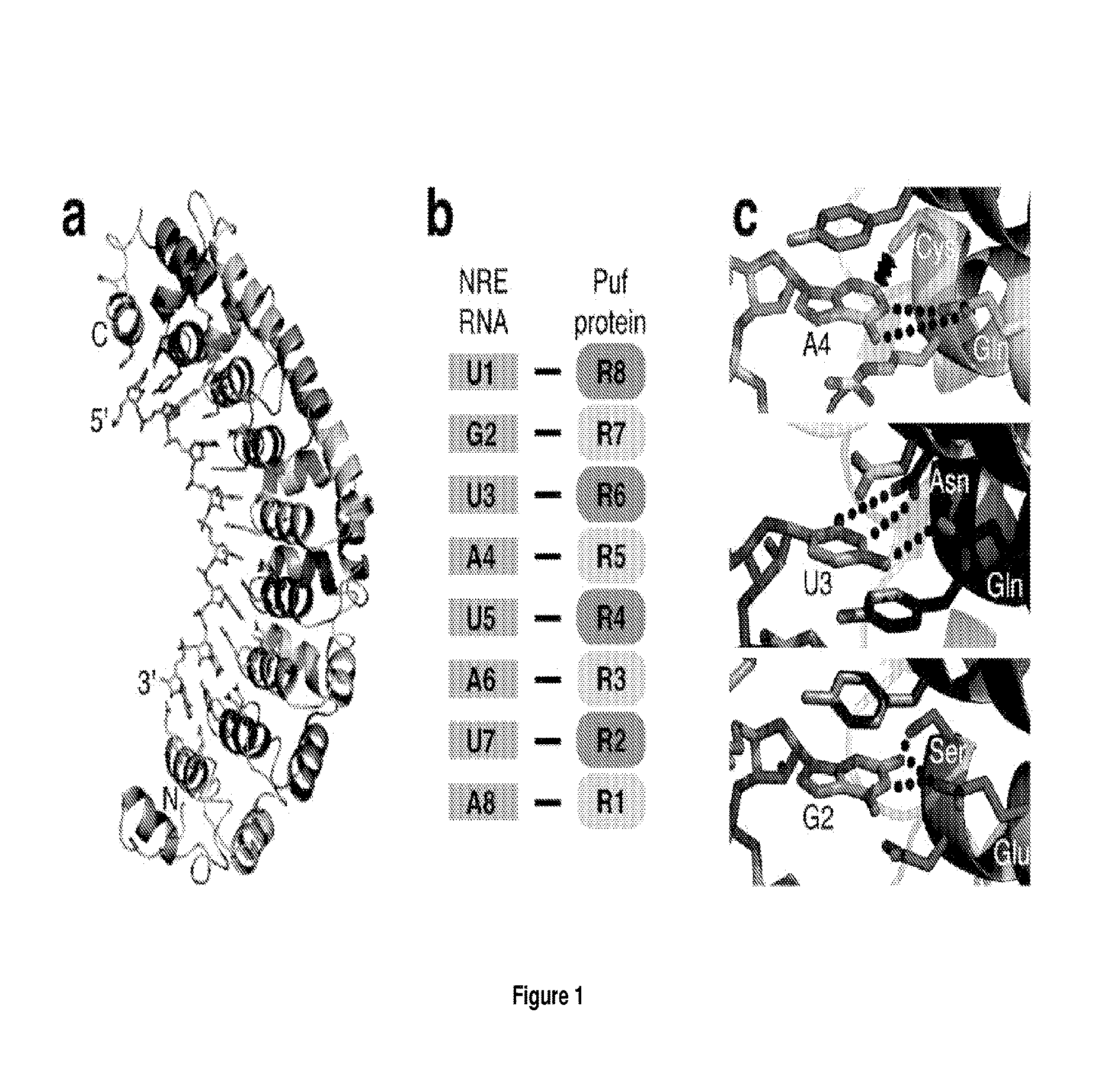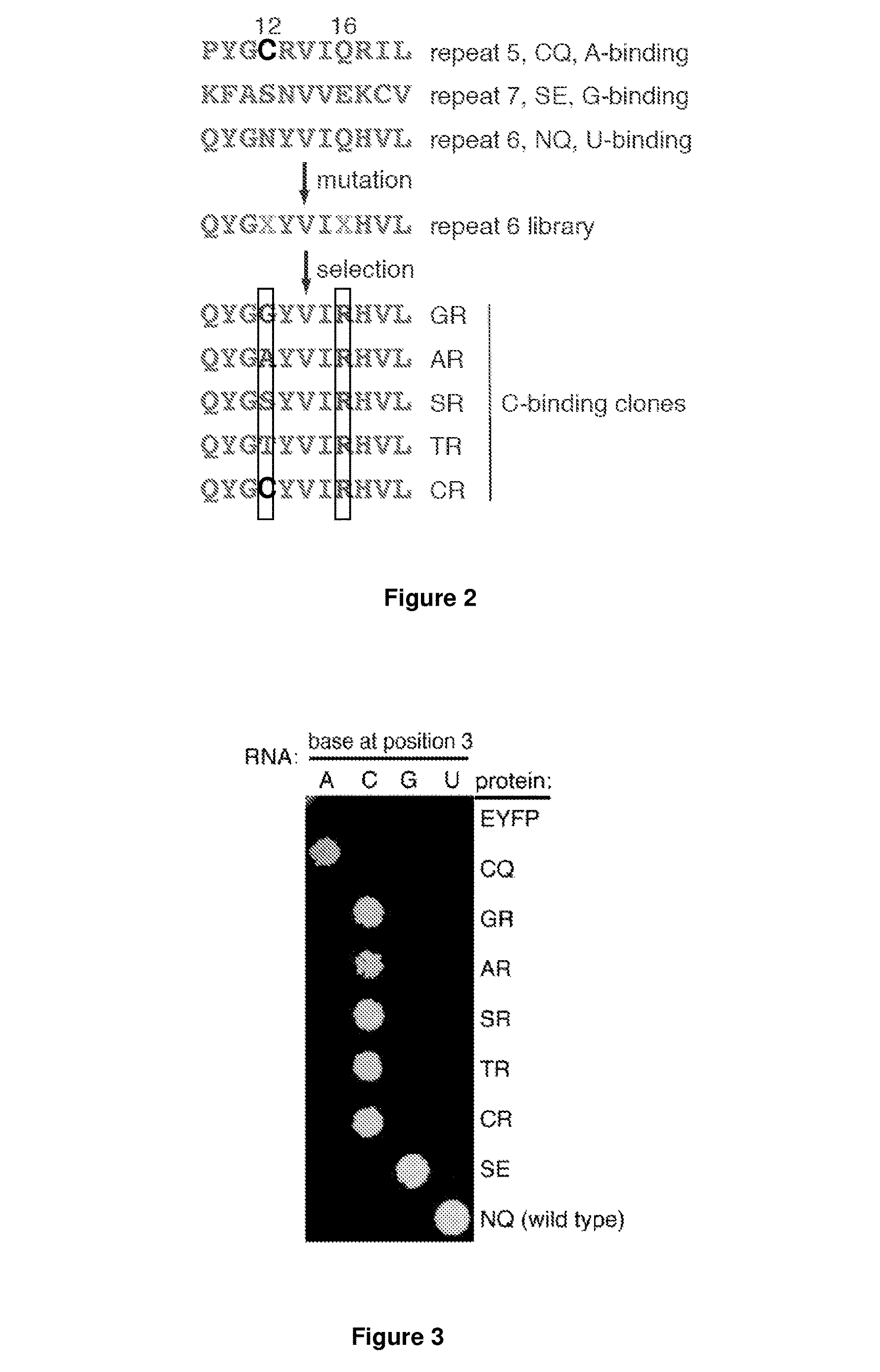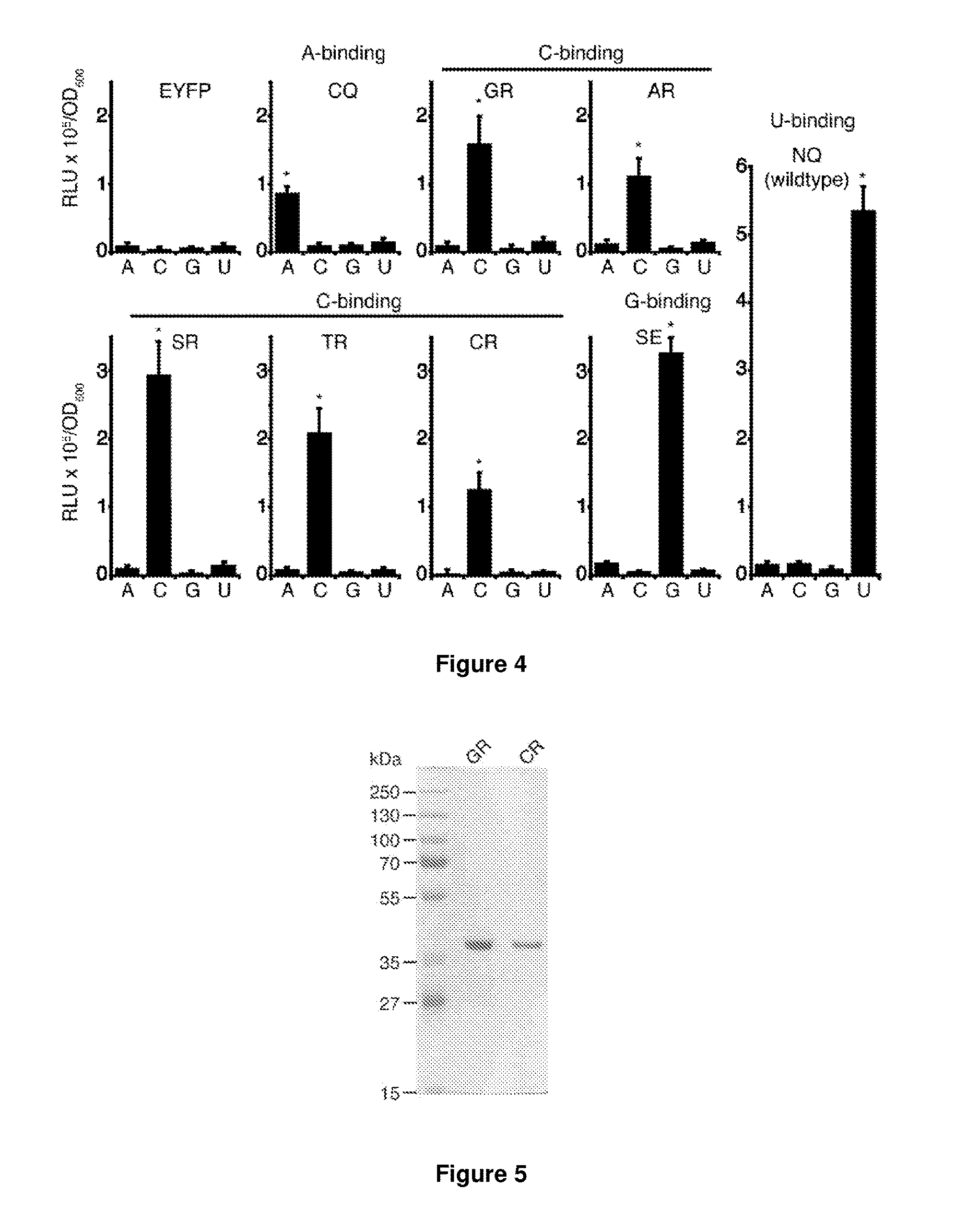Peptides for the specific binding of RNA targets
a technology of peptides and targets, applied in the field of recombinant polypeptides, can solve the problems of limiting the number and sequence of potential mrna targets, challenging and complex production of these molecules, and high complexity of the design of functional sirna that is appropriately recognised by the rnai cellular machinery
- Summary
- Abstract
- Description
- Claims
- Application Information
AI Technical Summary
Benefits of technology
Problems solved by technology
Method used
Image
Examples
example 1
Introduction
[0258]Referring to FIGS. 1 and 2, PUF (Drosophila Pumilio and Caenorhabitis elegans FBF homology) domains are typically composed of eight 36 amino acid repeats repeat binding to a single nucleotide in its extended RNA target via hydrogen bonding or van der Waals contacts between amino acids at positions 12 and 16 and the Watson-Crick edge. The amino acid at position 13 makes a stacking interaction.
[0259]Although PUF domains with repeats that recognize adenine, guanine or uracil have been reported (Cheong, C. G. & Hall, T. M. (2006) PNAS 103: 13635-13639; Wang, X. / et al (2002) Cell 110: 501-512), the use of these PUF domains has been substantially hampered by the lack of residues known to specifically recognise cytosine.
Materials and Methods
Plasmids
[0260]To produce a Gal4p activation domain fused to a PUF domain, a synthetic gene encoding amino acids 828 to 1176 of the human PUM1 protein (GenBank accession no. NP_001018494, GENEART) was subcloned into pGAD-RC (pGAD-RC: I...
example 2
Materials and Methods
Plasmids
[0272]Plasmids expressing individual Puf domain mutants were prepared according to Example 1. RNA expression plasmids were also prepared according to Example 1, except that pairs of annealed oligonucleotides corresponding to the following RNA sequences were used (PUF recognition sequences in bold, site specific mutations underlined):
[0273]
(SEQ ID NO: 42)NRE:5′-CCGGCUAGCAAUUGUAUAUAUUAAUUUAAUAAAGCAUG-3′;(SEQ ID NO: 48)NREU1C:5′-CCGGCUAGCAAUCGUAUAUAUUAAUUUAAUAAAGCAUG-3′;(SEQ ID NO: 49)NREG2C:5′-CCGGCUAGCAAUUCUAUAUAUUAAUUUAAUAAAGCAUG-3′;(SEQ ID NO: 44)NREU3C:5′-CCGGCUAGCAAUUGCAUAUAUUAAUUUAAUAAAGCAUG-3′;(SEQ ID NO: 50)NREA4C:5′-CCGGCUAGCAAUUGUCUAUAUUAAUUUAAUAAAGCAUG-3′;(SEQ ID NO: 51)NREU5C:5′-CCGGCUAGCAAUUGUACAUAUUAAUUUAAUAAAGCAUG-3′;(SEQ ID NO: 52)NREA6C:5′-CCGGCUAGCAAUUGUAUCUAUUAAUUUAAUAAAGCAUG-3′;(SEQ ID NO: 53)NREU7C:5′-CCGGCUAGCAAUUGUAUACAUUAAUUUAAUAAAGCAUG-3′;(SEQ ID NO: 54)NREA8C:5′-CCGGCUAGCAAUUGUAUAUCUUAAUUUAAUAAAGCAUG-3′;(SEQ ID NO: 55)NREstem5:5′-...
example 3
Materials and Methods
Plasmids
[0277]Plasmids expressing individual Puf domain mutants were prepared according to Example 1, except that to make a 16 repeat Puf protein (PUF×2), repeats 1-8 of the human PUM1 cDNA were amplified using primers that incorporated flanking Sacl sites, digested with Sacl and cloned into an engineered Sacl site that encodes amino acids 1030 and 1031 of the synthetic gene encoding the PUM1 PUF domain. RNA expression plasmids were also prepared according to Example 1, except that pairs of annealed oligonucleotides corresponding to the following RNA sequences were used:
[0278]
NREx2 (SEQ ID NO: 59):5′-CCGGCUAGCAAUUGUUGUAUAUAAUAUAUUAAUUUAAUAAAGCAUG-3′;NREx2mut1 (SEQ ID NO: 60):5′-CCGGCUAGCAAUCCCUGUAUAUAAUAUAUUAAUUUAAUAAAGCAUG-3′;NREx2mut2 (SEQ ID NO: 61):5′-CCGGCUAGCAAUUGUCCCCUAUAAUAUAUUAAUUUAAUAAAGCAUG-3′
[0279]Yeast three-hybrid growth assays and β-galactosidase assays were carried out according to Example 1.
Results
[0280]Naturally occurring PUF proteins typically...
PUM
| Property | Measurement | Unit |
|---|---|---|
| pH | aaaaa | aaaaa |
| bed volume | aaaaa | aaaaa |
| size | aaaaa | aaaaa |
Abstract
Description
Claims
Application Information
 Login to View More
Login to View More - R&D
- Intellectual Property
- Life Sciences
- Materials
- Tech Scout
- Unparalleled Data Quality
- Higher Quality Content
- 60% Fewer Hallucinations
Browse by: Latest US Patents, China's latest patents, Technical Efficacy Thesaurus, Application Domain, Technology Topic, Popular Technical Reports.
© 2025 PatSnap. All rights reserved.Legal|Privacy policy|Modern Slavery Act Transparency Statement|Sitemap|About US| Contact US: help@patsnap.com



